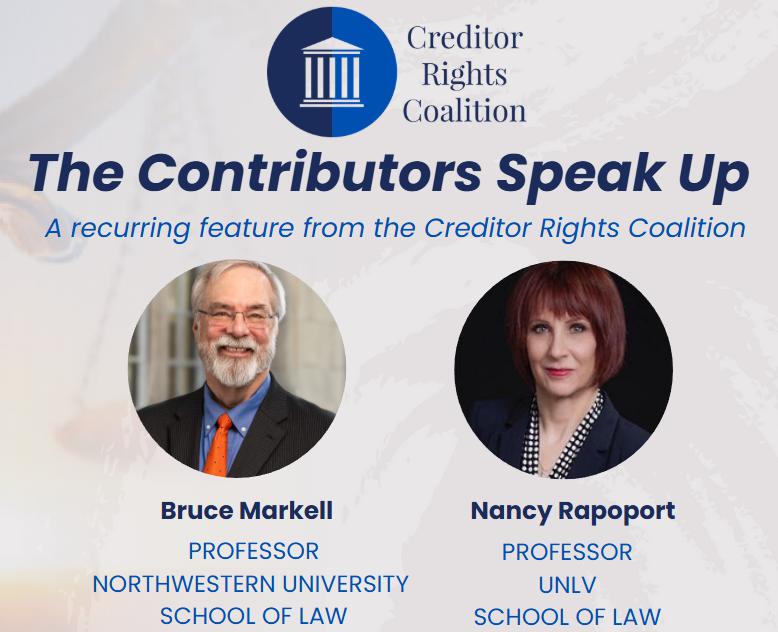The Academics Speak Up: Silvergate Part 2

Legal scholars Bruce Markell (Northwestern Law) and Nancy Rapoport (UNLV Law) sharply criticize the response of the Special Investigations Committee (led by Ivona Smith) to the Report of Stephanie Wickouski as Examiner in the Silvergate Bankruptcy. Both find fault in law firm Richards Layton & Finger representing a one-person investigative committee while also having ties to the debtor—creating what they argue is an unresolvable conflict of interest. Markell (a former bankruptcy judge himself) argues that the committee’s counsel, Richards Layton & Finger, mischaracterized key facts, downplayed real conflicts of interest, and relied on legal formalisms rather than addressing substantive concerns. Expert Rapoport highlights that state ethical rules bar this kind of dual representation. Their message: true independence matters, especially when investigating board conduct in complex bankruptcies with high stakes for investors and creditors.
Bruce Markell
Professor, Northwestern Pritzker School of Law
Although Silvergate may be mostly settled, and the motion to expand the examiner’s duties is off the calendar, the allegedly independent investigation committee’s response to the examiner’s report is both unsettling, and off-putting.
The response, filed by the committee’s counsel Richards Layton & Finger (RLF), is a maze of bafflegab. In an attempt to apparently zealously represent their conflicted client, RLF engaged in frequent and likely intentional mischaracterization and overstatement. It reminds me of the old saying is that if you don’t have the facts, you argue the law; if you don’t have the law you argue the facts. And if you have neither, you pound the table.
The response tries to pound the table. And even then, it misses the mark. Some examples of the whiffs:
- It says the examiner puts forward a per se rule. They should read their opponents pleadings. That phrase never appears, and their attempt to tar their opponents with that brush just results in more sticky stuff on them.
- They claim to represent a committee. But a committee is generally defined as a body having several members. This one had only one person. No diversity of views there, which underscores why the investigator should have had clear-eyed counsel to provide independent perspective.
- They assert that they are “conflict-free” because they were “retained shortly before the bankruptcy filing and well after the events giving rise to potential claims; [they] therefore had no involvement in the underlying conduct.”
And there is the rub. RLF was hired by the “committee” to assess whether Silvergate’s management would get a pass. But the people who made or approved the decision to hire RLF were the same flesh and blood humans who were under investigation, and who had previously hired RLF as Silvergate’s own lawyers. RLF contends that the client for both the “committee” and Silvergate was the same, so no conflict. That sophistry exhibits an overreliance on formalism at the expense of substance. Even if were true, however, the existence of the examiner’s report shows a legitimate disagreement about what was in the best interests of that client.
In case of such a disagreement, to whom does the common law firm listen? That conundrum is a conflict, and that conflict is exacerbated by the apparent fact that both the committee and RLF relied exclusively on documents curated by the debtors’ long-time counsel at Cravath and a limited number of witnesses provided by Cravath. In taking on the investigation, there wasn’t even a written retainer, and apparently minimal conflict checks.
Abraham Lincoln once posed the following riddle: “If you call a dog’s tail a leg, how many legs does it have?” and then answered his own query: “Four, because calling a tail a leg doesn’t make it one.”1 Strenuously and tendentiously pounding the table claiming that a conflict doesn’t exist doesn’t erase the conflict. Argument by adjective and innuendo rarely persuades. By not engaging the real issues, RLF says more about its advocacy than it does about the right result.
Warren Buffett once quoted Lincoln’s dog riddle when discussing how financiers talked about finance. He then added: “Abe would have felt lonely on Wall Street.” Anyone looking for persuasion in RLP’s response would feel similarly lonely.
Nancy Rapoport [1]
Professor, UNLV School of Law
Pay no attention to the man behind the curtain.2
When I read the Internal Investigation Committee’s Statement in Response to Report of Stephanie Wickouski as Examiner, my first thought hearkened back to one of my favorite scenes in 1939’s The Wizard of Oz: the quote that I’m using as my title of this essay. There are a lot of denials and excuses in the Statement in Response, but not much substance to any of them. My original essay pointed out that bankruptcy lawyers are bound by their state ethics rules just as all other lawyers are, so that the rule governing conflicts of interest applies. In a situation in which a law firm is representing both the debtor and a special board committee investigating bad behavior, the conflict is obvious. So of course I was interested in the response.
Let’s recap one of the basic principles about concurrent conflicts. Delaware’s concurrent conflicts rule 1.7 provides in part:
(a) Except as provided in paragraph (b), a lawyer shall not represent a client if the representation involves a concurrent conflict of interest. A concurrent conflict of interest exists if:
(1) the representation of one client will be directly adverse to another client; or
(2) there is a significant risk that the representation of one or more clients will be materially limited by the lawyer’s responsibilities to another client, a former client or a third person or by a personal interest of the lawyer…. [exceptions to Rule 1.7(a) omitted].3
The Statement in Response, though, tries this argument:
A newly retained counsel standing on one side of the investigation is conflict free. RLF was retained shortly before the bankruptcy filing and well after the events giving rise to potential claims; it therefore had no involvement in the underlying conduct. RLF also does not
represent any target of the investigation; it therefore stands on only one side of the investigation.4
But if a law firm is hired to represent the debtor in possession, that debtor in possession is still an inchoate entity—a piece of paper—acting through its board of directors.5 The single-person Special Investigation Committee was established to analyze the actions of the board (including whether the board should benefit from plan releases). To whom would this law firm answer? The directors whose actions were being investigated? The single-person SIC digging through the records? Not seeing a conflict there is willful blindness. The last-ditch argument—“[t]he Debtors act through their board for most matters. They act through the Committee for investigation matters”—doesn’t make sense if it’s the same law firm representing both entities. Not only could the representation of the SIC be directly adverse to the board members running the Debtor, but there is clearly “a significant risk that the representation of [the SIC] … will be materially limited by the lawyer’s responsibilities to [the Debtor, whose board may have acted in violation of its fiduciary duties].” In this situation, dual representation just doesn’t work.
The pale argument that the law firm was new to representing the Debtor also fails.6 When a law firm has a current client, the concurrent client rule doesn’t care if the representation was a day old or started with the birth of the firm itself.7 Here, the law firm should not have pitched the SIC at all. The conflict was not consentable, and the effect of the dual representation made the SIC’s report suspect from the get-go.
And here’s proof: The SIC voted in favor of the plan and its releases before finishing the investigation. That very act, despite the Statement’s best efforts to obscure the import of that vote, shows either that the SIC should have received better counsel from the firm (“delay the vote”) or that the SIC wasn’t independent. Arguing that “[t]he Examiner misses that the Plan releases [of the board members] are subject to the investigation’s conclusions, so the investigation need not conclude before the Plan can be filed” is not persuasive. Voting in favor of releases before an investigation concludes is the looking-glass version of having the Red
1 The actual quotation appears to have used sheep rather than dogs. I’ve also seen horses substituted. But any quadrupled animal will suffice to make the point.
2 The Wizard of Oz (MGM 1939).
3 Del. L. R. Pro. Conduct 1.7(a).
4 Internal Investigation Committee’s Statement in Response to Report of Stephanie Wieckowski as Examiner, at 2 [hereinafter Statement in Response].
5 Del. L. R. Pro. Conduct 1.13(a) (“A lawyer employed or retained by an organization represents the organization acting through its duly authorized constituents.”). See also id. 1.13(b), which says in part, “(b) If a lawyer for an organization knows that an officer, employee or other person associated with the organization is engaged in action, intends to act or refuses to act in a matter related to the representation that is a violation of a legal obligation to the organization, or a violation of law which reasonably might be imputed to the organization, and is likely to result in substantial injury to the organization, the lawyer shall proceed as is reasonably necessary in the best interest of the organization.”
6 “The Committee selected Richards, Layton & Finger, P.A. (“RLF”) to advise it with respect to the investigation. RLF was a new advisor to the company. The Debtors retained the firm about six weeks earlier, on July 2, 2024. Until then, RLF had no relationship with the Debtors.” Statement in Response at 9.
7 See, e.g., Jet Song, West Side Story (1957) (“When you’re a Jet/You’re a Jet all the way/From your first cigarette/To your last dyin’ day.”)
